Winter equipment suppliers tell Emma Kelly about their latest products – and why it pays to listen to customers
Preparing for winter operations is a year-round task for many airports that are located in the icy and snowy regions of the world. With changes in global weather patterns, cold snaps can often extend into spring and airports are usually in full winter planning mode in the summer months, building their arsenal of de-icers, snow ploughs and sweepers in preparation for the chilly times ahead.
Equipment and solution developers are working with their airport customers to develop and implement innovative solutions and meet their changing requirements to ensure airports are as well prepared as possible for whatever winter may bring, as well as addressing their efficiency and sustainability requirements.
“We are constantly working towards new technologies and capabilities,” said Emilie Boschung, head of marketing and communications at Swiss surface condition management company Boschung Group. Boschung highlighted the group’s innovations over the decades: “We were the first to launch a sweeper/blower vehicle – the Jetbroom – in 1985 and the first to be able to detect snowfall and ice formation in 1964; the first to launch a fully electric sweeper on the market in 2018 and the first to launch a fully electric all-wheel drive multipurpose carrier in 2020. We are inventors, constantly looking to be ahead of the game.”
The company offers a complete and interconnected suite of products for year-round airport operations, with a focus on detection, action and management, Boschung said.

Preparation is everything when it comes to keeping airports operational throughout the winter season
Forewarned is forearmed
Boschung’s detection products assess a surface condition and include an ice early warning system, featuring a weather station equipped with the r-weather compact atmospheric sensor able to provide accurate information on visibility, precipitation type, intensity and quantity, air temperature, relative humidity, dew point, barometric pressure and wind speed and direction. In addition, its active pavement sensors measure freezing point, while its automated take-off and landing assessment system (ATLAS) is a comprehensive solution to meet International Civil Aviation Organization (ICAO) global method for runway condition assessment, able to automatically detect and measure parameters, including contaminant type, depth and coverage without requiring the runway to be closed.
Under the action category, Boschung’s products include the Urban-Sweeper S2.0, which is a fully electric sweeper with an option to be autonomous; and the Pony P3.0 fully electric all-wheel drive multipurpose carrier used for winter and summer maintenance. For snow clearing, Boschung offers the Snowbooster Series of snowblowers featuring state-of-the-art technologies, as well as the high-speed Jetbroom Series.
It features a 6m-plus long brush equipped with the patented Quattro-Jet system that delivers a larger cleaning width and more speed. “It’s a system that makes the Jetbroom the most powerful work tool today,” Boschung added.
High-speed de-icing is provided by Boschung’s SDA Series de-icing technology that can cover a width up to 30m, distributing solid, liquid and mixed de-icing agents, while the FAST solution (fixed automated spray de-icing technology) features an entirely automated liquid de-icing system automatically triggered by active sensor technology.
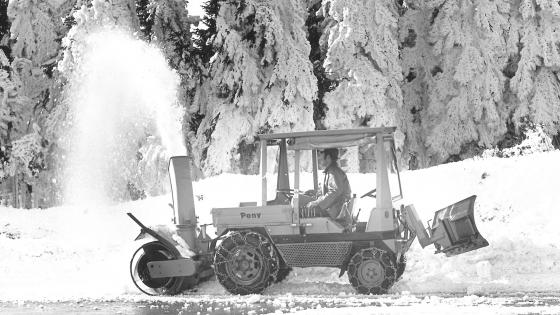
The first generation of Boschung’s Pony, seen here in 1970
We got here because of our passion for innovation and the quality of our work
Building on existing tech
Over the last two years alone, Textron GSE has introduced a number of developments to its Premier and Safeaero de-icers, said Matt Chaffin, vice president and general manager at Textron GSE.
For example, Guardian technology has been added to the Premier products which protects them from costly damage caused by incorrect start-up and shutdown procedures, while Intellimix technology has been added to the Safeaero 220 de-icer, eliminating the need to purge the expensive fluids used in the de-icing process by instead circulating heated fluids and mixing them at the nozzle.
Chaffin said: “Textron GSE is always looking to optimise its product offerings and utilises customer feedback to develop meaningful solutions that support on-time operations.”
Textron’s de-icers are in operation worldwide at both large and small airports. “Premier de-icers are trusted and known for their reliable performance and Safeaero products are built for global operations and are infused with innovations that enhance productivity,” he added.
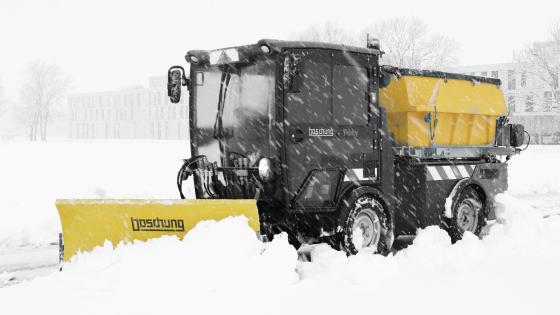
The Pony P3.0 is fully powered by electricity, and features a Boschung-engineered 54.4kWh lithium-ion battery
Flexibility rules
The Safeaero 220, for example, was the industry’s first single-operator de-icer, which can be driven, positioned and operated from one cab. It features automotive steering, wireless data transfer, remote diagnostics, state-of-the-art blend and spraying, and can service commuter aircraft up to the Airbus A380.
Intellimix, meanwhile, is designed to maximise efficiency, reduce waste and deliver the perfect blend of heat and fluid, said Chaffin: “Intellimix was developed to offer precise mixing of fluids at the nozzle, which eliminates the need to purge fluids, reducing operation costs and the impact to the environment.”
Textron’s Safeaero Typhoon is an open basket de-icer that offers simple operation, superior reliability and a working height up to 16m, while the Premier range includes de-icers with working heights up to 15m and multiple de-ice and anti-ice tank capacities.
Premier units feature Express heat technology which delivers single-pass instant heat, while most feature the Guardian technology which reduces human error and costly damage.
An optional Express Start system is also available, which automates the start-up sequence with the touch of a button and offers remote access for diagnostics.
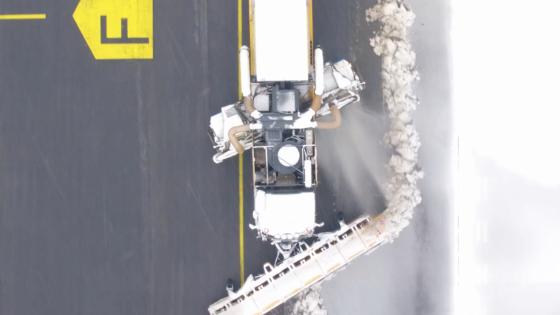
The Jetbroom is a multi-functional, high-performance snow clearing vehicle, featuring a one-piece heavy-duty chassis built for extreme conditions
Ongoing development
“Textron GSE continually evaluates its product portfolio to look for opportunities for both new product development and design enhancements that will support its customers and the demands of the industry, As part of that process, we research new technologies and collaborate with industry leaders to ensure we develop the right innovative products that will exceed expectations and position ground support operations for the future,” Chaffin told Airports International, pointing to a prototype lithium repower kit it recently demonstrated at GSE Expo in Paris. “This captured interest from attendees, showcasing an opportunity to transition existing fleets of internal combustion tractors and transform them into lithium solutions,” he said.
With the majority of its customers looking to reduce their environmental impact, Textron GSE has committed to offering a hybrid or lithium option in 80% of its product categories by 2035, Chaffin revealed.
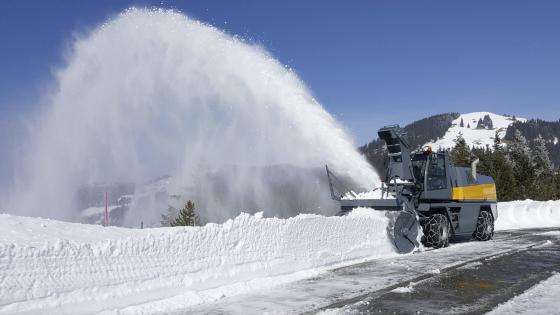
The Snowbooster series has a clearing capacity of up to 5,000 tons per hour
Developments are always based on customer feedback, which Chaffin described as “the foundation of our process”. He said: “We gain insight from customers to understand how a product is utilised, what product gaps exist and any obstacles customers face with existing products.”
Boschung too is constantly looking to develop its products. “Most of the products are those we have had in our portfolio for many years and have been constantly re-engineered over the years,” Emilie Boschung said. The Jetbroom, for example, is now a sixth-generation product, based on the original concept of a brush in between the front and back axles and a blowing unit.
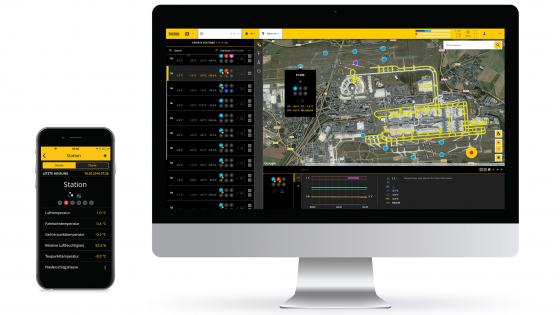
All Boschung solutions connect to its managing platform, bVision, enabling airports to forecast, track and analyse connected weather stations
Electrification and automation
Danish company Vestergaard continues to work on development of its de-icer product range, said sales manager Lars Barsøe. Vestergaard offers a range of aircraft de-icers, which can de-ice any aircraft type – from the smallest corporate aircraft up to the A380 – with electric, hybrid and diesel versions available.
“We are constantly upgrading equipment and developing fully electric versions of the various sized de-icers, and we are working on an efficient electrical heating solution for the fluid,” he said. “We have a plan to turn all of our equipment into electric equipment over the next couple of years and we are working to optimise energy consumption and charging solutions for our electric vehicles.”
Vestergaard has more than 2,000 de-icers in operation around the world, with almost 30 electric de-icers delivered over the past year, with “many more to come” and electric units operating in both Europe and the United States, said Barsøe.
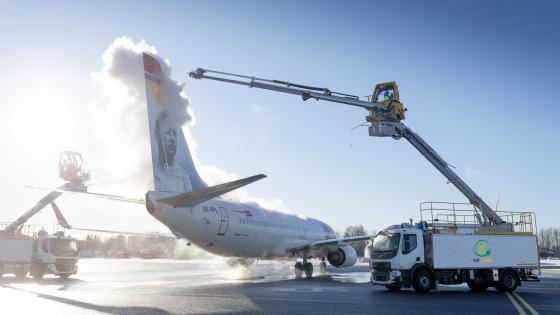
Finnish aviation services specialist Airpro has ordered four Vestergaard Elephant e-BETA de-icers for use at Helsinki Airport
For smaller airports, Vestergaard has the e-Mini MY Lite de-icer on an electric chassis. The e-Mini MY Lite, which can service aircraft up to Boeing 757s with a tank capacity of 4,000l, was launched in 2021. The first version featured the Vestergaard 12 T electric chassis with diesel heaters.
Vestergaard launched a version with electrical heating of the fluid at the GSE Expo in September. It comes with a 40 or 60kWh battery, can handle eight-12 de-icings depending on the rate, and can drive 40-75km on a single charge.
It comes with an onboard charger for the chassis and a plug-in charger forthe heater.
The move to electric equipment is in direct response to customer requests, Barsøe said. “We always try to match our products and development plans to our customers’ requirements and wishes. The push to electrify all equipment is a strong desire in the market and also the push for automation is strong so that customers can use fewer staff or use staff with less training,” he said. As a result, the European company is working towards automation, with plans for implementation over the next couple of years.
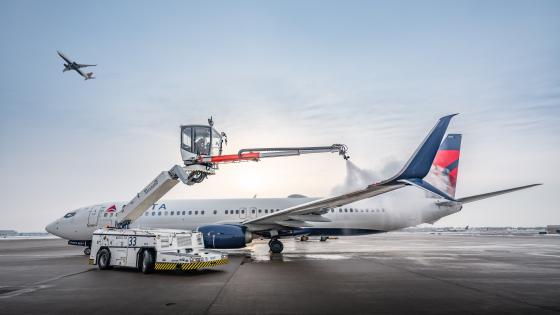
Intellimix technology circulates heated fluids and mixes them at the nozzle of the Safeaero 220 de-icer
The after-sale support is just as important to customers as the equipment they buy
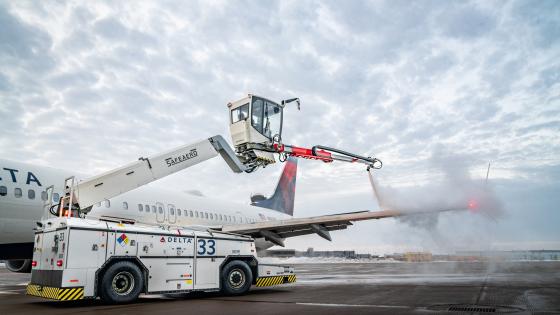
The Safeaero 220 was the industry’s first single operator de-icer
Cutting CO2 emissions
Snow plough and snow blower company Zaugg AG Eggiwil is focusing on CO2-neutral solutions in its product development. “The most important thing right now is to get CO2 neutral emissions which means an alternative drive to diesel engines. That’s what we are working on,” said Adrian Jezzone, international sales manager at the Swiss company.
Zaugg supplies attachment snow blowers for all kinds of carrier vehicles: Rolba snow blowers from 230-1,000hp; Monoblock loader-mounted snow blowers with an auxiliary engine of 230hp or 380hp; and snow ploughs for different uses and different sizes. All of its vehicles have been updated to meet Step V engine emission requirements, but carbon neutrality is the next goal.
Effective tools and platforms to manage the winter fleet are also increasingly important. All of Boschung’s solutions, for example, are connected to its managing platform, bVision, which allows airports to forecast, track and analyse connected weather stations; the FAST automated spray system; maintenance vehicles; and tools on the same platform.
An operator can connect all of Zaugg’s machines to a GPS- or GSM-based system so the customer can follow the machine in real time and know exactly where and how it is working, said Jezzone.
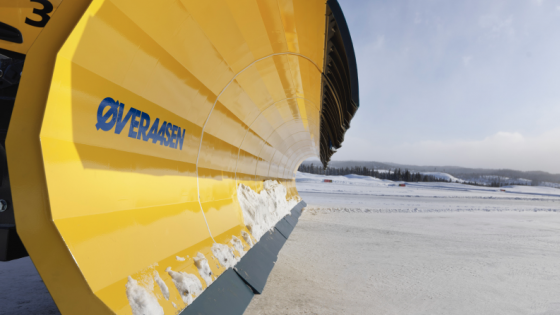
All 12 of Avinor’s new RS 600s arrived in time for winter 2022 and will be used as the primary snow removal vehicles
Customer satisfaction
Quality, efficiency, longevity and value are what drive operators to a particular supplier. Boschung believes its innovation and quality make it a supplier of choice for airports worldwide.
“We are a family-owned business with over 75 years of experience,” said Emilie Boschung. “We got here because of our passion for innovation and the quality of our work. We have been working together with our customers over the years making sure we can provide the perfect solution for their needs to keep their surfaces safe all year long.”
Likewise, Zaugg believes its experience across a number of areas and ability to work with each customer is why they return. “Zaugg AG Eggiwil is one of
the world’s leading companies in the development and manufacturer of high-end equipment for snow clearance on roads, ski slopes, airports and railways,” said Jezzone. “The company has seen strong growth in recent years thanks to ongoing innovation and the ability to adapt to customer needs.
”Vestergaard Elephant de-icers are known for their quality and efficiency, said Barsøe, adding that the total cost of ownership of its equipment over a period is attractive. “We have customers who purchase our units, customers who lease equipment from us and then a number of customers who lease/rent through third-party asset companies.”
Chaffin said Textron’s longevity and reputation in the industry, along with product range and backing of a major aerospace group, are all factors in its success. “Our brands are trusted and renowned for delivering reliable, durable and safe products that can support on-time departures and the rigoursof ramp operations,” he said, addingthat the company’s offering encompassesa wide range of equipment that canbe purchased and supported in one cohesive transaction.
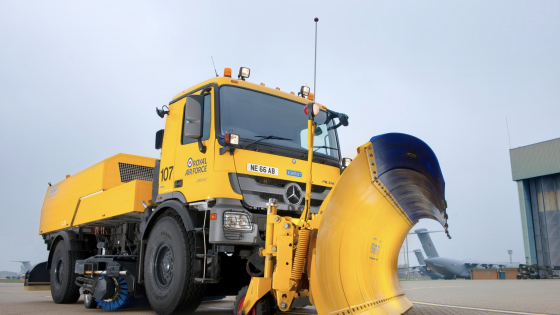
RAF bases around the world are using a new fleet of Mercedes-Benz-based airfield sweeping and snow clearing vehicles, commissioned by Aebi Schmidt UK
Mercedes-Benz Trucks also benefits from its longevity and well-known brand, with its Unimog snow vehicle relied on by airports worldwide. “We are the oldest truck producer worldwide. Our trucks and special trucks have been designed for all sorts of operations under the most challenging conditions. The Unimog, for instance, is specially designed for winter operations,” the manufacturer said.
For many decades, Mercedes-Benz Trucks has been closely cooperating with manufacturers including Bucher Municipal and AebiSchmidt to winterise their vehicles, with snow ploughs, snow cutters and salt spreaders. Unimog features front and rear power take-off, up to four hydraulic circuits, up to 24 drive gears or a hydrostatic drive, making it ideal for demanding winter operations.
Product support is extremely important for airports to ensure their vehicles are ready each winter. Vestergaard’s Barsøe said his company is known for its extensive customer support. “We provide preventative maintenance, ad hoc maintenance and we have service vehicles on the road all summer performing summer overhaul on de-icers throughout Europe and North America.”
Textron, meanwhile, has a network of travelling technicians and airport shops to support customers year-round. “This team has extensive knowledge of Textron GSE products and decades of expertise maintaining ground support equipment,” said Chaffin. He added: “The after-sale support is just as important to customers as the equipment they buy.”
Autonomy in different systems can increase efficiency at the airport and that is something we always strive towards
Need to know more: Wireless solutions
It’s not just about electric and automated solutions, with the latest wireless technologies also providing opportunities to deliver improvements in winter operations. UK-based wireless communication provider dBD Communications, for example, has launched a multi-user de-icing pad wireless duplex solution that is designed to safely increase turnaround de-icing times.
The solution allows up to four de-icing operators to communicate wirelessly with each other around an aircraft while de-icing. It consists of dBD’s Apollo system base unit located in one de-icing machine which is wirelessly connected to the headsets of all four de-icing operatives. The solution has a range of up to 150m, or with additional antennas up to 300m.
The system allows all operators to talk and listen at the same time, providing uninterrupted wireless communications around an aircraft. Multiple headset and microphone options are available, including fully blocked headsets, single ear headsets or a speaker and microphone. The system integrates with ramp and air traffic control radio communications, improving situational awareness; can easily be moved from one de-icing team to another; and two or more systems can work side-by-side without any sort of interference, according to dBD.
Need to know more: Autonomous operations
Ensuring safety of operators, passengers and aircraft is a priority in both equipment manufacturers’ development of new technology and airports’ implementation of it.
“Safety is always at the forefront of what we look to integrate, from greater visibility for the operator, to e-stops to collision avoidance technology like Smart Sense,” said Matt Chaffin, vice president and general manager of Textron GSE. Smart Sense uses ultrasonic sensors attached to the front of the vehicleto stop and slow it down when needed.
Autonomous operations is a case in point. Norwegian airport operator Avinor, for example, is adopting a step-by-step, safety-first approach with its introduction of autonomous snow sweepers. In 2021, it signed an eight-year deal with Norwegian equipment provider Øveraasen for the purchase of 12 RS 600 fully autonomous runway sweepers, featuring an autonomous solution from software company Yeti Move.
The cloud-based autonomous solution, which has been under development fora number of years, is designed to increase the efficiency of snow clearing and reduce delays at airports.
Avinor had one autonomous vehicle for testing at Oslo Airport throughout winter 2021/22, with a second arriving during late winter/early spring 2022.
“The operations went well last winter and we tested the vehicles live, but not with autonomy,” said Harald Nygaard Kvam, head of communications at Oslo Airport.
Avinor is ready to move onto the next stage, however: “We have implemented and tested the autonomous part, but always with a driver onboard, unless it has been in a closed part of the airport,” Kvam told Airports International.
“This winter all 12 RS 600s have arrived and will be used as the primary snow removal vehicles. We hope to have them driving autonomously during the winter season, but we cannot be 100% sure, as safety always comes first,” added Kvam. “This is one of those projects that takes the time it takes. There will, in the beginning, be a driver in the foremost vehicle in any case, as a safety precaution even when they drive autonomously.” The sweepers clear the runway in a chain of six vehicles, driving slightly behind each other.
If the autonomous operation is successful at Oslo, the plan is to implement it elsewhere. “Autonomy in different systems can increase efficiency at the airport and that is something we always strive towards,” Kvam said.
Avinor’s focus is currently on the autonomous sweepers, but it is interested in further technology developments. “We have a strategy to be technology driven. So yes, we are always interested [in new technology], but for now the focus for winter operations is on the RS 600 vehicles.”
